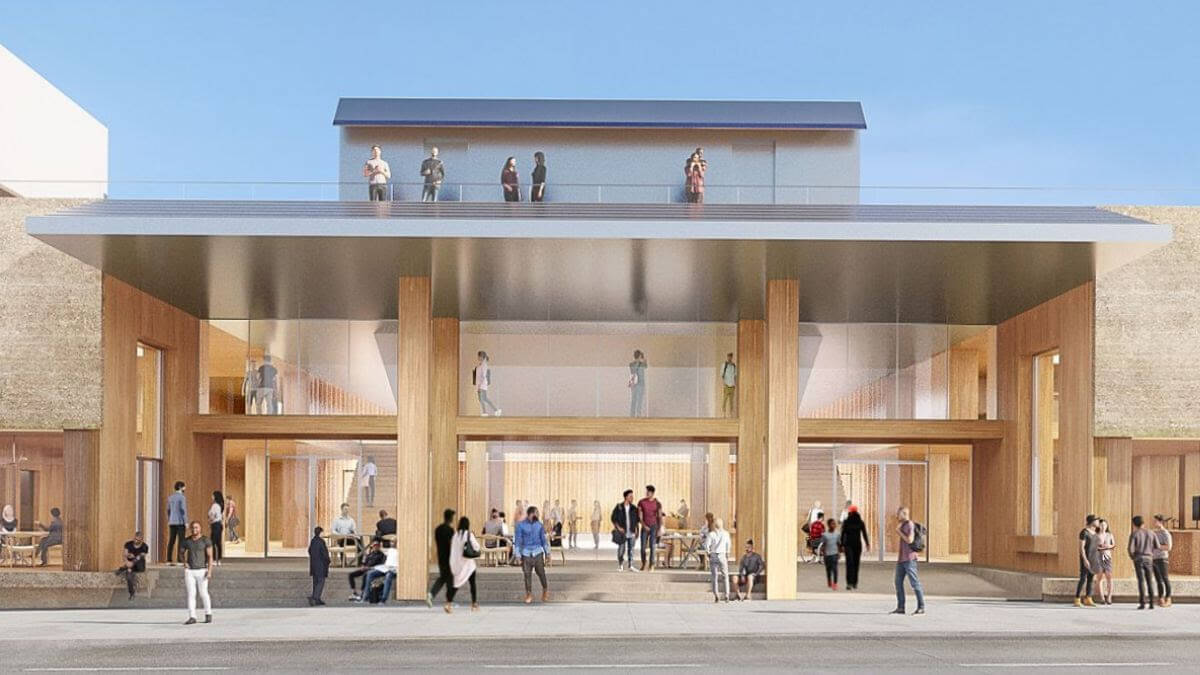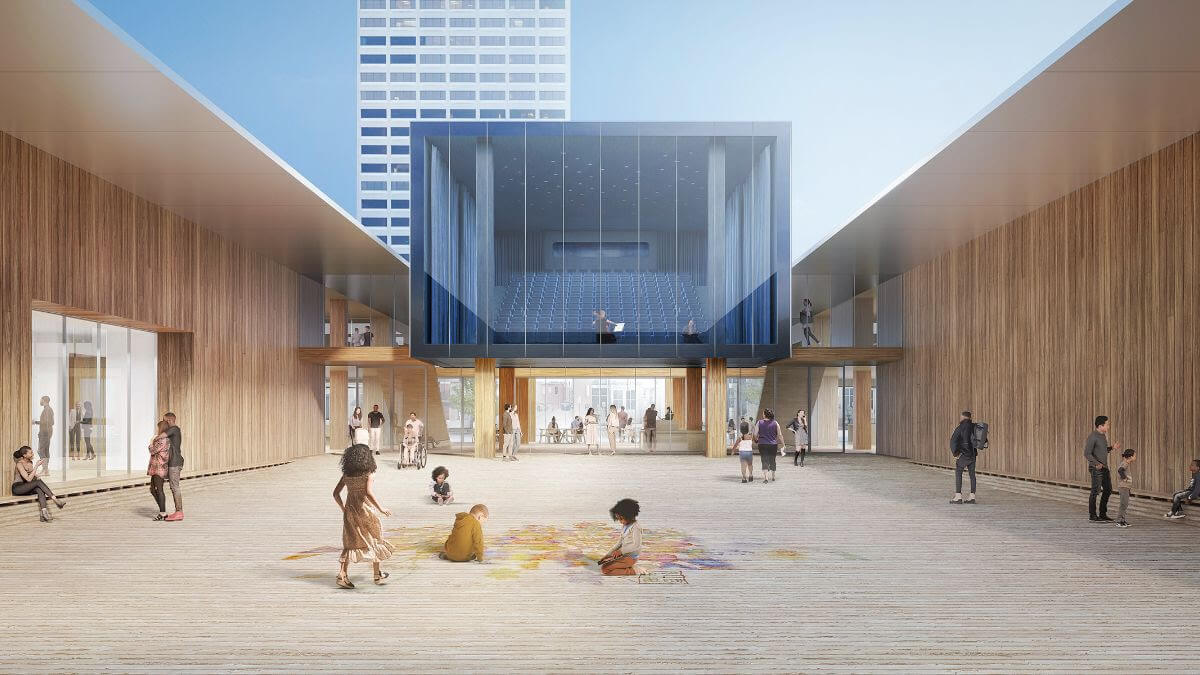The Memphis Brooks Museum of Art, the largest and oldest art museum in the state of Tennessee, has revealed the design concept for its new home perched atop a promontory overlooking the Mississippi River in one of the oldest sections of Bluff City. The 112,000-square-foot building is designed by Herzog & de Meuron in partnership with red-hot Memphis architecture and design collective archimania. The pair was tapped by the museum to design the new facility in 2019, beating out a formidable shortlist of contenders that included Diller Scofidio + Renfro, Johnston Marklee, and OMA. Construction work on the $150 million project is expected to commence late next year following a design development, bidding, and demolition (a fire station at the site will be razed) phase with a grand opening slated for 2026.
The Brooks’ current home at historic 342-acre Overton Park is within a U.S. National Landmark-designated Beaux-Arts structure designed by James Gamble Rogers that has been thrice expanded in 1955, 1973, and 1989, with that last addition replacing the 1955 one. The landmark building has served the museum well over the decades. However, the aging structure is beset with leaks, climate control issues, and paltry storage space. The new riverfront museum that will rise near historic Beale Street on Cotton Row will be about 25 percent larger than the existing facility and will enable the fabled Memphis institution to considerably expand its exhibition galleries, offer additional community and educational programming, and assert its presence in an evolving downtown Memphis. (It’s unclear how the museum’s current 105-year-old Overton Park home, which Brooks first announced plans to decamp from in 2017, will be repurposed but ideas are in the works.)
When completed, the relocated Brooks Museum will anchor a cultural corridor that’s in the works along a six-mile-long swath of the Memphis riverfront. The city’s park-studded, recreational trail-laced riverfront reactivation plan was developed by Studio Gang in partnership with SCAPE for the Mayor’s Riverfront Task Force and the Memphis River Parks Partnership.

“The new Brooks will become an essential civic space for the people of Memphis and visitors to our city,” said Memphis Mayor Jim Strickland in a statement. “Our city has long been known for its rich culture and history; soon we will be able to better share the visual art of our region and the stories embedded in Memphis’ art collection at the Brooks.”
As detailed by the Brooks in a press announcement, the new museum building is envisioned as a glass pavilion with textured, earthen cladding and wood elements. Situated on a bluff directly above a historic cobblestone river landing, the museum’s base will be “forged” out of the ridge and support the upper part of the low-slung building while providing tucked-away space for parking and other uses. The museum’s galleries will all be located on a single level to provide a more seamless viewing experience for museum-goers; galleries showcasing the museum’s permanent collection—including the famed Samuel H. Kress Collection of Renaissance and Baroque paintings—and focus galleries are organized in a continuous, looping fashion around a wood-clad central courtyard that will serve as an “outdoor room” for a variety of planned programming and individual visitor experiences.
“As a volume, it extends the city’s original street grid to the river by way of a set of steps leading down to a viewing platform, where the building mass frames vistas of the Mississippi River and wetlands beyond,” wrote the museum. In addition to courtyard access, the galleries will be linked to the main entrance lobby in several spots while the education- and family-dedicated spaces are also adjacent to the main level’s exhibition areas. At street level, there are plans for a cafe, museum store, and large gallery for temporary exhibits.

Positioned above the main entrance is a 175-seat theater and an adjacent terrace that opens out to Front Street at roof level. “A west-facing wall of glass provides an overlook of the museum’s diagonal sweep,” explained the museum of the theater space. “It can be obscured with exterior shading and interior drapery to provide an opaque backdrop for interior performances or it can transform into a dramatic screen facing out into the courtyard. At the right time of day, a visitor will be able to gaze out the window and catch the setting sun casting a golden light on the courtyard below.”
Herzog & de Meuron have envisioned the museum as a building that possesses five distinct facades including its roof, which will feature landscaping and an accessible deck where visitors can take in sweeping river and city views. Described as a “kind of announcement card for the museum,” the expansive roof will be visible from Memphis’s two Mississippi-spanning bridges, from the air, and from nearby downtown office towers including a redeveloped 100 North Main.
“We’ve aimed to design a welcoming civic landmark that upon approach explains itself visually and from the inside reminds the visitor where he or she is in relation to a legendary river and an historic city,” said Herzog & de Meuron cofounder Jacques Herzog. “The result will be a museum that’s both in Memphis and of Memphis, a landmark that couldn’t be anywhere else.”
When the new museum opens in 2026, the reinstallation of the permanent collection will “tell a story of art that dissolves the usual dividing lines between eras and mediums,” the museum explained. “Rather than the traditional emphasis on national schools, the rehanging will showcase works within the inter-related geographies of Europe, the Americas, Africa and the global contemporary.” There will also be a renewed emphasis of contemporary African American Art at the Brooks; the museum has announced plans to acquire works from contemporary Black artists including Sanford Biggers, Rick Lowe, and Vanessa German with funds from the Joyce Blackmon Fellowship prior to reopening in its new riverfront home.
“We at the Brooks understand that we’re in a unique position to consider what an art museum can be in the 21st century,” said Mark Resnick, executive director of the Brooks, in a statement. “We’re beyond gratified to enter this next chapter in our new home, tailored-made to our needs.”











